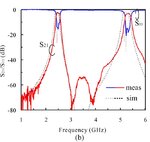ctzof
Full Member level 3

Hello,
I want to design a bandpass filter at 2.45 GHz with 100 MHz bandwidth. I don't care about a specific frequency response and a 2nd or a 3rd order filter would be good. The thing is that I want to build this filter with lumped components (LC), is that possible in such a high frequency? any suggestions? I want to use mostly 0402 and 0603 components. The main reason I want to build this filter with discrete components is because I want to have the ability to have a base structure and change later the components to make it work at 5.8 GHz (150 MHz BW) any other ideas on how I can make this? The board is a multiband software defined radio transceiver
I want to design a bandpass filter at 2.45 GHz with 100 MHz bandwidth. I don't care about a specific frequency response and a 2nd or a 3rd order filter would be good. The thing is that I want to build this filter with lumped components (LC), is that possible in such a high frequency? any suggestions? I want to use mostly 0402 and 0603 components. The main reason I want to build this filter with discrete components is because I want to have the ability to have a base structure and change later the components to make it work at 5.8 GHz (150 MHz BW) any other ideas on how I can make this? The board is a multiband software defined radio transceiver





